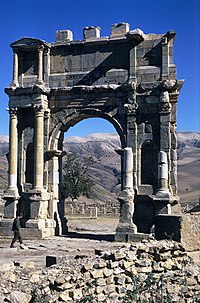Djémila
| Djémila | |
|---|---|
|
UNESCO world heritage |
|

|
|
| Emperor Caracalla Arch |
|
| National territory: |
|
| Type: | Culture |
| Criteria : | (iii) (iv) |
| Surface: | 30.6 ha |
| Reference No .: | 191 |
| UNESCO region : | Arabic states |
| History of enrollment | |
| Enrollment: | 1982 ( session 6 ) |
Djémila ( Arabic جيميلة Dschīmīla ) is the current name of the ancient city of Cuicul in Numidia in North Africa(today in Algeria in the so-called Kabylia ). The ruined city has been a UNESCO World Heritage Site since 1982. It is located at an altitude of 900 m in the Wilaya (Province) Setif . The settlement is on a mountain spur between two wadis .
history

Cuicul was originally a Berber settlement that became a Roman veterans' colony under the Emperor Nerva at the end of the 1st century AD . The city flourished from the 2nd to the 4th centuries. It owed its prosperity primarily to agriculture - North Africa was considered to be a “granary” of Rome because of the more humid climate at the time.
In the course of time the built-up area increased. The last expansion dates from around 400. During this time the so-called Christian quarter was built with a double church complex, baptistery and bishop's residence. Under vandal control since 455, the city fell to the Byzantine Empire in 533/34. The last time Cuicul was mentioned was 553. But even after that, the city was probably still inhabited until the Arab conquest in the second half of the 7th century.
Cuicul is still a titular bishopric of the Catholic Church today .
ruins
Two forums , several basilicas, temples, Christian churches, triumphal arches and richly furnished private houses have been preserved. The city is considered a good example of Roman urban planning adapted to mountain conditions. It also owned thermal baths , a capitol and a theater.
The temple, which was dedicated to the emperor Septimius Severus (193–211 AD) and his wife Iulia Domna , is well preserved. His son Caracalla (211-217) had the triumphal arch of Djémila built in 216 AD .
First excavations began in 1909 and continued until 1957. The most important finds, including large mosaics, are exhibited in the Djémila Museum. The archaeological sites are endangered by both sandstorms and the use of the stones for modern homes.
In 1858, Henry Dunant founded the joint stock company of the mills of Mons-Djémila (French: Société financière et industrial des Moulins des Mons-Djémila ), a mill business near the Roman ruins of Djémila.
literature
- Paul-Albert Février: Cuicul (Djemila) Algeria . In: Richard Stillwell et al. a. (Ed.): The Princeton Encyclopedia of Classical Sites. Princeton University Press, Princeton NJ 1976, ISBN 0-691-03542-3 .
- Marcel Le Glay : Cuicul. In: The Little Pauly (KlP). Volume 1, Stuttgart 1964, column 1338.
Web links
- 18 artistic photos (French)
Individual evidence
- ↑ Entry on the website of the UNESCO World Heritage Center ( English and French ).
- ↑ Further information and pictures ( Memento of the original dated February 11, 2006 in the Internet Archive ) Info: The archive link was inserted automatically and has not yet been checked. Please check the original and archive link according to the instructions and then remove this notice. (French)
- ^ Swissinfo: Quand des Suisses créaient une colonie privée en Algérie
Coordinates: 36 ° 19 ′ N , 5 ° 44 ′ E






